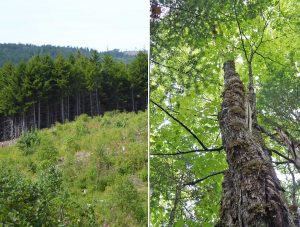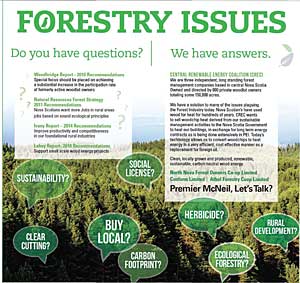Minor edits made Sep 27 a.m.
Can the Nova Scotia Government set climate- and ecologically-smart standards for forest bioenergy?

Curved arrows represent biologically mediated flows of GHGs: the straight arrow, industrial emissions of GHGs; and the symbols at bottom right. long term sequestration of carbon in the oceans
In a half page colour ad on page A12 of last Saturday’s (Sep 22, 2018) Chronicle Herald, North Nova Forest Owners Co-op limited, Conform Limited and Alhol Forestry Coop Limited say to Premier McNeil “Let’s talk” [about forest bioenergy].
Their case, under the heading “We have answers” (bolding mine):
We are three independent long standing forest management companies based in central Nova Scotia. Owned and directed by 800 private woodlot owners totaling some 150,000 acres. We have a solution to many of tho issues plaguing the Forest Industry today. Nova Scotian’s have used wood for heat for hundreds of years, CREC wants to sell woodchip heat derived from our sustainable management activities to the Nova Scotia Government to heat office buildings, in exchange for long term energy contracts as is being done extensively in PEl. Today’s technology allows us to convert woodchips to heat energy in a very efficient, cost effective manner as a replacement for foreign oil.
Clean, locally grown and produced, renewable, sustainable, carbon neutral wood energy
View other content of the ad below.
I am empathetic to this initiative by this particular group of forest management companies. (View a recent post about some of their activities.) The initiative can be seen as following directly from Recommendation 35 in the Report from the Independent Review Vol 1:
35. DNR and other relevant agencies of the provincial government, along with municipal governments and regional development agencies, should work together with project developers to support and enable small‐scale wood‐energy projects that will allow low quality wood to be used in heating hospitals, schools, government office buildings, correctional facilities, and other public buildings.
However… and it’s a big “However”, a major shortcoming of the Lahey Report is that there is very little else, and essentially no cautionary messages, about forest bioenergy (or “forest biomass”).
The next-to-no-consideration by the Independent Review of issues around forest biomass/bioenergy, as Raymond Plourde has pointed out, occurred in spite of “Biomass” being identified as the top issue “relating specifically to the industry included forest sector employment” (next were “the operation of WestFor in western Nova Scotia, transparency of decision making and the economic importance of pulp and lumber mills”) – see pp 4-5 in the IR Report Addendum.
I had hoped (re my submission Sep 18, 2017) but not expected (re post June 27, 2018) that the Independent Review would address the biomass issue in depth. What I did expect was that the Independent Review would recommend that LCAs (Life Cycle Assessments) be required for any forest bioenergy project to establish that it is truly carbon neutral and otherwise sustainable. The Report from the Independent Review does not even mention LCAs.
 The danger is that without boundaries set on forest bioenergy, small scale projects that may be “carbon neutral” and ecologically sustainable as claimed, too easily slide into larger projects that are clearly not “carbon neutral” and not ecologically sustainable (or even economically sustainable without major subsidies), the outstanding case being Nova Scotia Power’s Port Hawkesbury biomass electricity (60 MW) plant. Other projects under the guise of “green fuels” and the like that are also highly dubious from GHG and ecological perspectives have been simmering for for some time with support from the Dexter NDP and McNeil Liberal governments.
The danger is that without boundaries set on forest bioenergy, small scale projects that may be “carbon neutral” and ecologically sustainable as claimed, too easily slide into larger projects that are clearly not “carbon neutral” and not ecologically sustainable (or even economically sustainable without major subsidies), the outstanding case being Nova Scotia Power’s Port Hawkesbury biomass electricity (60 MW) plant. Other projects under the guise of “green fuels” and the like that are also highly dubious from GHG and ecological perspectives have been simmering for for some time with support from the Dexter NDP and McNeil Liberal governments.
With few details being available about the forest management group (North Nova Forest Owners Co-op limited, Conform Limited and Alhol Forestry Coop Limited) proposal, I can’t really speculate on whether it could be “carbon neutral”. If the biomass is based largely on true sawmill wastes and/or thinnings (rather than clearcut biomass) and the biomass is used only to generate heat (not electricity) using the most efficient technology, it could well be “carbon neutral” compared to oil, probably not compared to natural gas. This is where rigorous LCA/carbon modelling is required to make the claim that the scheme is carbon neutral over meaningful time frames, e.g. with a carbon parity time of 20 years or less.
____________________
*The “carbon parity time” is the number of years after initiating a forest bioenergy project that GHG emissions would be higher than if a specified fossil had been used. The time to carbon debt repayment may also be pertinent.

Two approaches to managing woodlots in Nova Scotia: even-aged management at left, multi-aged management at right. Only the latter protects older forest biodiversity and could maintain carbon stocks high enough to qualify for carbon credits
It would make a lot of sense, I would think, for the forest management group to involve LCA analyses/carbon modelling in shaping their proposal. Perhaps they are doing that. (Who knows, if they are proposing to use mainly thinnings, perhaps they are even figuring out how to maintain sufficient carbon stocks to qualify for carbon credits at the same time.)
On the government end, it would be a progressive move to introduce publicly available, independently conducted or reviewed LCAs/carbon modelling as a requirement for claiming that any bioenergy project is carbon neutral, specifying the carbon parity time as 20 years (or less). Also, permissible feedstocks, related forest management activities and burner/boiler technology need to be specified. The proposal by the forest management group – recognized as a group pursuing truly sustainable and environmental friendly forestry – looks as though it would be a good starting point.
I refer to LCAs/carbon modelling rather than just LCAs because recent reviews indicate significant limitations to traditional LCAs if used as the sole tool for assessing carbon neutrality and ecological sustainability of forest biomass projects.*
_______________________
*E.g., see Liu et al., 2018: A critical analysis of the carbon neutrality assumption in life cycle assessment of forest bioenergy systems Environmental Reviews 26: 93–101 (2018); Bentsen, 2017: Carbon debt and payback time – Lost in the forest? Renewable and Sustainable Energy Reviews 73: 1211-1217; Mihalle et al., 2016. Using Life Cycle Assessment to Evaluate the Sustainability of British Columbia’s Forest based Bioeconomy. Prov. B.C., Victoria, B.C. Tech. Rep. 101; A global meta‐analysis of forest bioenergy greenhouse gas emission accounting studies
Matthew et al., 2016. Global Change Biology: Bioenergy 8: 281-289
It’s time to put Lands & Forestry’s new carbon modeller to work on this issue, also for L&F/NS Mines and Energy/Climate Change Nova Scotia to conduct an open consultative process* to set forest biomass standards including, finally, the application of nutrient budgeting as one of the tools for assessing sustainability. (Development of DNR’s Forest Nutrient Budget Model was initiated in 2008 as a tool for assessing sustainability of biomass harvesting. Keys et al reported on the model in 2016, but it has yet to be implemented. View page on Calcium Depletion; and post Aug 13, 2018)
__________________
*As advised by the Lahey Report Vol 1 for such processes.
Introducing scientifically sound, conservative (erring on the side of precaution), transparent standards for forest bioenergy would very likely (say 99% likelihood) put the kibosh on NSP’s claims – and the government’s acceptance of those claims – that their biomass based electricity is “renewable energy”. On that score, the government could decide to phase out the Port Hawkesbury biomass system, or transition it to a system compatible with the new standards.
A major benefit of such steps: an end to ‘biomass battles’ in Nova Scotia, which is kind of where the path to the Independent Review began. It would also put Nova Scotia ahead of the curve in formally recognizing limitations to forest bioenergy as a tool for reducing GHG emissions* and be consistent with our values (re: EGSPA), our technical capabilities and a high level of related scientific research and scientific literacy in Nova Scotia.
__________________________
*See Opinion: Reconsidering bioenergy given the urgency of climate protection
John M. DeCicco and William H. Schlesinger in PNAS Sep 25, 2018 Vol 115: 9642-9645. Thx to PR, a climate-literate Nova Scotian, for forwarding this piece just published in the prestigious Proceedings of the National Academy of Sciences. “To reduce the concentration of carbon dioxide in the atmosphere, DeCicco and Schlesinger point out, requires increasing the rate at which trees and other plants remove it from the air. Although they don’t rule out possible breakthroughs in algae or other futuristic bioenergy options, they say that for now the best biologically based carbon dioxide reduction strategy is to protect and restore carbon-rich natural ecosystems.” – Univ Michigan Press Release Sep 28, 2018
It would be Nova Scotia Smart and Climate Smart.
‘Some thoughts. I hope I am not just daydreaming.
——————————————————–
 Other content of the Ad:
Other content of the Ad:
Under the heading “Do you have questions” they reference following
– Woodbridge Report – 2010 Recommendations
Special focus should be placed on achieving a substantial increase in the participation rate of formerly active woodiot owners– Natural Resources Forest Strategy – 2011 Recommendations
Nova Scotians want more Jobs in rural areas, jobs based on sound ecological principles– Ivany Report – 2014 Recommendations
Improve productivity and competitiveness in our foundational rural industries– Lahey report – 2018 Recommendations
Support small scale wood energy projects
And the following are in ‘question bubbles’ emanating from a forest:
Sustainability?
Clearcutting?
Buy local?
Social License?
Carbo footprint?
Herbicide?
Ecological Forestry?
Rural Development?
——–
Some related posts:

Depending on its source, even use of wood or pellets for home heating can increase GHG emissions. As a fuel, wood has a pollutant emissions profile similar to coal; those can be greatly reduced with use of appropriate burner technology.
– Nova Scotia forests, forestry and GHGs 2: Who accounts for the EU’s emissions from bioenergy generated from imported chips?
Posted on July 27, 2018
– Nova Scotia forests, forestry and GHGs 1: Letters
Posted on March 25, 2018
– NSP, PHP, NSDNR and FSC appear to be complicit in burning primary biomass from Loon Lake area, increasing GHG emissions, and calling practices “sustainable”
Posted on March 17, 2018
– Great Northern gears up Musquodoboit Pellet Mill
Posted on February 13, 2018
– Bancroft on the real costs and dismal returns to Nova Scotians of running the PHP biomass plant 24/7
Posted on February 7, 2018
– Are biofuels from Nova Scotia forests good for the environment? Show us the science!
Posted on May 4, 2017
– We can “cut less and do more” to foster a healthy forest economy in Nova Scotia
Posted on April 20, 2017
– Natural Resources Canada GHG Calculator confirms Nova Scotia forest bioenergy schemes are worse than coal
Posted on January 3, 2017
